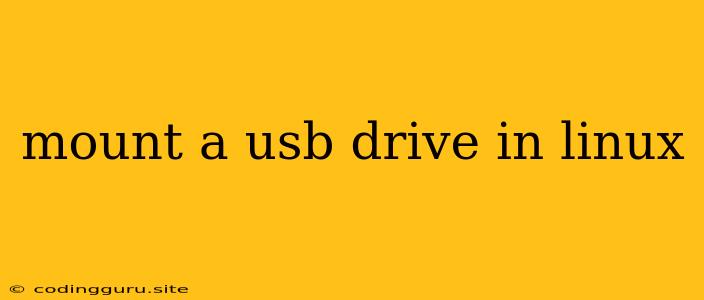How to Mount a USB Drive in Linux
Connecting and using a USB drive in Linux is a straightforward process. Linux automatically detects most USB devices, making it easy to access your files. Here's a guide on how to mount your USB drive in Linux.
1. Connect Your USB Drive
The first step is simple: plug your USB drive into an available port on your computer. Linux will automatically detect the drive and assign it a device name, typically in the format /dev/sdX, where X is a letter like a, b, or c.
2. Find Your USB Drive's Device Name
To identify the correct device name for your USB drive, you can use the lsblk command in your terminal. This command provides a tree-like representation of your storage devices.
Example Output of lsblk:
NAME MAJ:MIN RM SIZE RO TYPE MOUNTPOINT
sda 8:0 0 238.5G 0 disk
└─sda1 8:1 0 238.5G 0 part /
sdb 8:16 0 7.4G 0 disk
└─sdb1 8:17 0 7.4G 0 part /media/user/MyUSB
In this example, sdb is the device name for the USB drive, and sdb1 is the partition within the drive.
3. Create a Mount Point
Before you can mount your USB drive, you need to create a directory where the contents will be accessible. This directory is called a mount point. It's best practice to create a dedicated mount point for each USB drive you use.
Example:
To create a mount point called MyUSB under the /media directory, use the following command:
sudo mkdir /media/MyUSB
Note:
/mediais a common location for mounting removable media, but you can choose any directory.- The
sudocommand is required to create a directory in the/mediafolder, which has restricted permissions.
4. Mount the USB Drive
Now you're ready to mount the USB drive. Use the mount command, specifying the device name and the mount point:
Example:
sudo mount /dev/sdb1 /media/MyUSB
This command mounts the partition sdb1 of your USB drive to the directory /media/MyUSB.
5. Access Your Files
After mounting, you can access the files and folders on your USB drive by navigating to the mount point you created. In this case, you would open the /media/MyUSB directory.
6. Unmount the USB Drive
When you're done with the USB drive, it's crucial to unmount it before removing it from your computer. This ensures data integrity and prevents file system errors.
To unmount the USB drive, use the umount command:
Example:
sudo umount /media/MyUSB
After unmounting, you can safely eject the USB drive from your computer.
7. Auto-Mounting (Optional)
You can configure your system to automatically mount your USB drive whenever it's connected. This is useful for drives you frequently use.
Tips:
- Use
fstab: The/etc/fstabfile is used for configuring automatic mount points. Add an entry for your USB drive in this file, specifying the device, mount point, file system type, and mount options. - Graphical tools: Some desktop environments offer graphical tools to manage mounts and automounting, like the "Disks" application in GNOME.
8. Troubleshooting
If you encounter issues mounting your USB drive, try these steps:
- Check permissions: Ensure you have the necessary permissions to mount the drive. Use the
sudocommand if needed. - Check for errors: Run
dmesgto check for any error messages related to the USB drive. - Verify file system: Ensure the file system on the USB drive is compatible with Linux (e.g., ext2, ext3, ext4, NTFS, FAT32). Use the
filecommand to check the file system type. - Repair file system: If you suspect file system corruption, try repairing it with tools like
fsck.
9. Conclusion
Mounting a USB drive in Linux is a simple process that allows you to access the files on your drive easily. By following these steps, you can securely connect and manage your USB drives on your Linux system.
